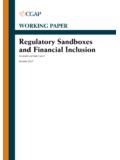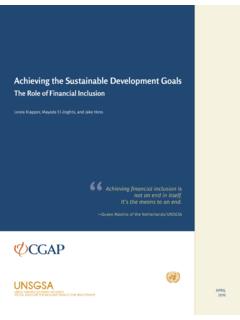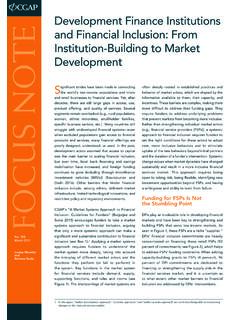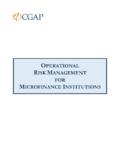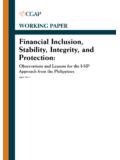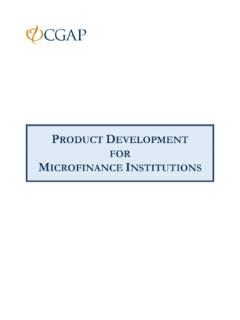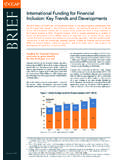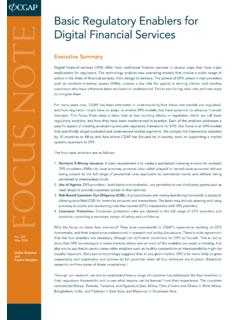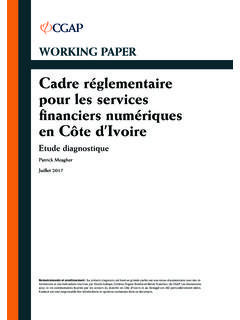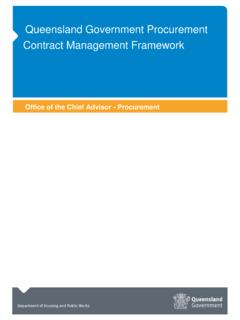Transcription of Commercial Loan Agreements: A Technical Guide …
1 Commercial LoanAgreementsA Technical Guide for microfinance InstitutionsCommercial LoanAgreementsA Technical Guide for microfinance InstitutionsCommercial LoanAgreementsTechnical GuideThe Consultative Group to Assist the Poor (CGAP) is a global resource center formicrofinance standards, operational tools, training, and advisory services. Our 33members including bilateral, multilateral, and private donors are committed tobuilding more inclusive financial systems for the poor. For more information aboutCCGAP or microfinance , visit LoanAgreementsA Technical Guide for microfinance InstitutionsConsultative Group to Assist the Poor Prepared for CGAP by Cleary, Gottlieb, Steen & Hamilton, LLP 2006 Consultative Group to Assist the Poor/The World BankAll rights material in this publication is copyrighted.
2 Copying and/ortransmitting portions or all of this work without permission may bea violation of applicable law. The Consultative Group to Assist thePoor encourages dissemination of its work and will normally grantpermission promptly and Group to Assist the Poor1818 H Street, , DC 20433 Internet : : + of Guidebook1 Negotiating Perspective of the Borrower3 General Overview3 Preliminary Considerations3 Term Sheet3 Alternatives to a loan Agreement4 Type of Loan8 Standard loan agreement Provisions15 Introductory Provisions15 Recitals15 Definitions15 Financial Terms16 Commitment to Lend16 Disbursements17 Repayment of loan Principal18 Voluntary Prepayment of loan Principal19 Fixed Interest Rate21 Table of ContentsFloating Interest Rate21 Interest on Late Payments22 Fees23 Expense Reimbursement24 Performance Commitments25 Representations and Warranties25 Covenants28 Events of Default32 Remedies36 Enforcement37 Confidentiality38 Entire Agreement39ivTable of ContentsThe Consultative Group to Assist the Poor would like to
3 Thank the following Cleary, Gottlieb,Steen & Hamilton LLP staff who were instrumental in developing and writing this techni-cal Guide : Francesca Lavin, Penelope Christophorou, Jeremy Pam, Janet Morris, AndrewAspen, Yasmin Moorman, Carlos Lozada, Jean Arakawa, Sameera Fazili, and ClaraVondrich. We also thank various industry practitioners, particularly Deborah Burand, LindaValentine, and Dawn McGee, for their guidebook introduces borrowing microfinance institutions (MFIs or borrowers) toimportant provisions of a standard Commercial bank loan agreement . It does notprovidean exhaustive description of the contents of a loan agreement . (In any event, standardforms of loan agreements vary depending on several factors, including the lender, thecountry in which the lender is located, borrower characteristics, and loan size.)
4 This Guide -book, therefore, should be used by borrowers as general , lenders will want to use their own agreement form as the basis for nego-tiating with borrowers. Much of a draft loan agreement comprises standard (boiler-plate) provisions, and banks are sometimes reluctant to consider changing these pro-visions. Other clauses in a loan agreement , however, are specific to the transaction. Theymay need to be customized to reflect the individual features of the lending relation-ship in first draft of a loan agreement proposed by lenders is just that a should study its terms carefully and, where necessary or commercially reason-able, negotiate the terms to ensure funds will be available to them when needed and theywill be able to carry on their normal business per the agreement .
5 Theoretically, every loanagreement provision can be negotiated, but in practice, a borrower s negotiating strengthdepends on its bargaining power. A local borrower may find that bargaining powerincreases with the longevity of its relationship with the guidebook offers tips for drafting standard clauses. Borrowers should use thisguidebook to help them understand the risks associated with some of the important pro-visions of a loan agreement . This guidebook also can help borrowers identify departuresfrom generally accepted provisions that may negatively affect their agreements commonly are evidenced by the signing of a loan agreement , apromissory note, or both. A loan agreement is a contract between the lender and the bor-rower that sets forth the terms and conditions of the loan (including its repayment) andthe rights and obligations of both of GuidebookA promissory note, by contrast, is simply a written promise by the borrower to paya stated amount of money in accordance with certain terms, which include the principalamount of the loan , a specified rate of interest, and a maturity date.
6 The main difference between a loan agreement and a promissory note is length. Promissorynotes typically are much shorter and less detailed than loan agreements. Moreover, promis-sory notes often are used together with loan agreements to provide supplemental evidence ofthe promises to pay the amounts specified in the loan agreement . Occasionally, the debt obliga-tion represented by a promissory note is secured by the borrower s specific assets, in which casethe promissory note may be called a collateral note. Although promissory notes are not essen-tial, because a loan agreement alone sufficiently records the transaction and binds the parties,they may provide some advantages to the borrower in certain jurisdictions. (For more informa-tion, see Alternatives to a loan agreement Promissory Notes.)
7 This guidebook addresses only standard Commercial loan agreements governed bylaws of common law legal , it does flag, in broad terms, some notabledistinctions between the way common and civil law handle terms and practices withrespect to loan agreements and promissory type of legal system that applies to the loan agreement is critical, because commonlaw and civil law legal systems involve different approaches to the respective rights of credi-tors and debtors. Common law and civil law systems may use different legal terms; may rec-ognize different types of liens (legal interests in the borrower s assets); may offer different typesof self-help remedies to creditors; and may apply, through local courts, different interpreta-tions to terms and conditions.
8 Borrowers should ask local legal counsel whether the law gov-erning the loan agreement follows common law or civil law principles and what the relatedimplications are. Indeed, borrowers should seek local counsel to understand how this issue (aswell as a number of other issues highlighted throughout this handbook) applies to guidebook describes various loan agreement structures and standard provisions,including those relating to representations and warranties, covenants, events of default,remedies, enforcement, and confidentiality. It also covers Commercial loan agreements andcertain alternative loan products, defines loan agreement terminology, and explains therisks and benefits of some common loan loan Agreements1 Most Latin American and continental European jurisdictions have civil law systems, while most of the United States, mostmembers of the British Commonwealth, and some former British colonies have common law systems.
9 Among Asian andAfrican nations ( , South Africa, Zimbabwe, Botswana, Philippines, and Sri Lanka), it is not uncommon to encounter mixed jurisdictions that have elements of both civil law and common law traditions. In some cases, most notably amongMiddle East countries ( , Iran, Egypt, and Syria), a jurisdiction s legal framework is mixed in that it integrates civil orcommon law concepts into a religious or tribal law framework. General OverviewA borrower s principal objectives in negotiating a loan are as follows: Ensure funds will be available when needed. Obtain funds at the most advantageous financial terms possible ( , the lowest inter-est rate possible). Provide for the repayment of the loan over a period that will not place an undue bur-den on it.
10 Ensure it can comply with all other terms of the loan agreement (such as financialcovenants) in its ordinary course of lender s objectives for the loan agreement are as follows: Set out the conditions under which it will be obligated to disburse funds under the loanagreement. Enable it to monitor the borrower s financial situation and, when necessary, to takeremedial action if the borrower experiences serious financial difficulties. Provide itself with a legally enforceable claim to its funds, or access to other remedies,if the borrower ConsiderationsTerm SheetMost loan negotiations begin with the lender preparing a document variously called atermsheet, mandate letter, or engagement letter. This document sets forth importantterms of the loan , including key financial terms, such as the interest rate and repay-ment period.
